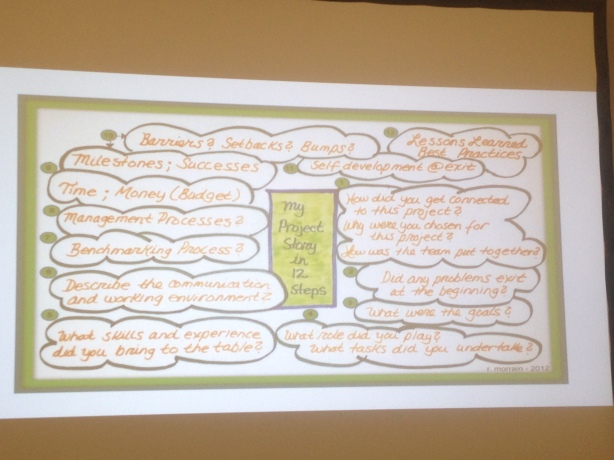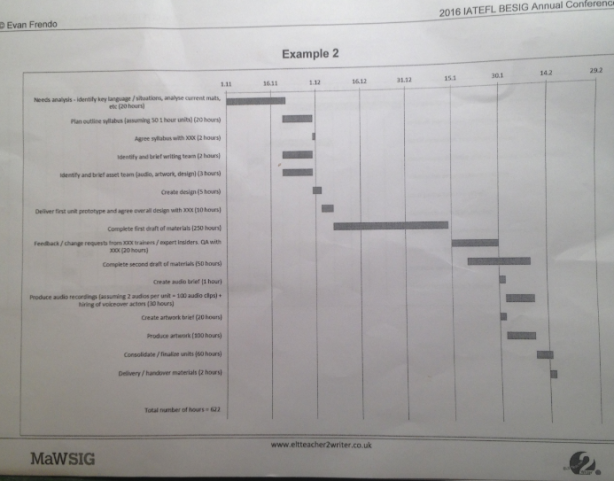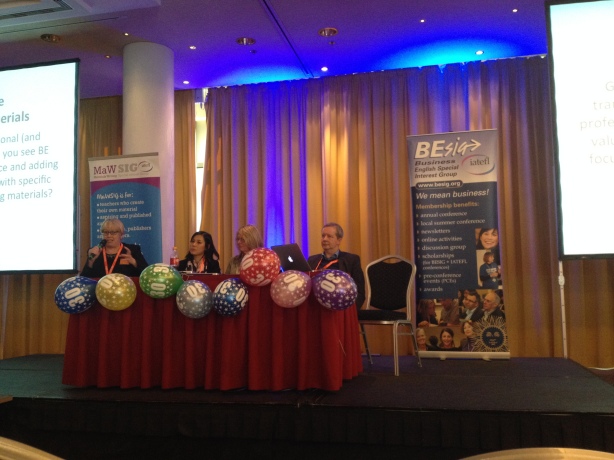I love mind mapping, so I couldn’t wait to hear what Ron has to share with us! Here are the notes from his workshop.

The work is based on eight years on research into mind-mapping and how they influence second language learning. The focus is on B1-B2-C1 Business English classroom.
Ron Morrain maintains that, if we are to be great teachers, we need to (1) attempt to integrate the 4 Cs: critical thinking, communication, collaboration and creativity, (2) Task-based Language Teaching and (3) understand Project-based learning.

Ron starts a lot of his classes immediately with a mind-map to win the learners over – in his experience, using them half-way won’t work. Here are some mindmaps that his learners do – notice two things:
- They’re based around questions, e.g. What do I expect from this course? It’s crucial to find out the learners’ expectations and beliefs from the outset.
- His mind maps have this ‘personal touch’ – they don’t have the feel that they were ‘produced in a Word document’. He draws them on A3 paper and laminates them.
- All of his bubbles are always numbered (to guide the learners / see the structure and logic – see also examples below.

In Ron’s school, they make no paper copies. In class, he passes his laminated copy around the class, the learners are responsible for getting a record – taking a picture, and then they navigate through the mind map using their own technology: tablets or smart phones, which makes it a ‘living object’ that they know where to find after the lesson. Also, it is the students who share the picture of the their electronic management system and it is their pictures that Ron uses when he projects them. Basically, this is part of
Another example, at the beginning of the course: these are the speaking topics that we’ll be dealing it:

Here are the writing topics:

Ron mostly uses mind maps to guide the learners to produce a product (and the product will always be based on a skill) – below is an mind map that guides the learners to produce a 200 word restaurant review that’s going to be posted online.

Again, notice how numbers highlight the structure of the review. The questions in the bubble prompt the learners to start researching on the internet (which takes care of input) – putting the learners in control of their learning. The learners must be result-oriented, and it is the them who choose what they’re going to read.
We moved on to discuss the ‘how’ of using the mind maps based on this mind map:

First, how does the use of mind maps encourages the use of the 4Cs and a range of other questions.
E.g. to introduce Critical Thinking he introduces bubble #4: thinking critically about their area.
What happens afterwards? The learners’ product is assessed (and all teachers in Ron’s school are paid to become examiners so that they’re skilled as assessing learning).
When the mind map is used for speaking (e.g. CV mind-map below, where the learners present themselves for their partner): they have to listen pro-actively and take notes. When he asks them, ‘Did your partner make any mistakes’? they can’t answer ‘I don’t know’.
More examples – there are more business-oriented.
Product for the mind map below: a presentation, leading to writing (a 200 word essay). Again, notice how the questions prompt the learners to go out, do their research and take their learning in their hands.



The company profile – the product here is not only a presentation but a Pecha Cucha. There are 10 bubbles, and they are only allowed 3 minutes to present their company. This is a great challenge for the learners and they love it.

So, to round up, here are some of the reasons to use this approach.
Mind-mapping
- reduces text-heavy materials
- promotes storytelling as the people are going to be talking about themselves
- promotes online learning
- removes ‘talk and chalk’
- incorporated different teaching approaches, e.g. TBL
- a wonderful way to elicit target language in a natural way
One participant (Kirsten Waechter’s) take-away: I should learn to trust my learners more and ‘let go’.
You can find an example of a lesson plan that uses a mind map that Ron created for Shanthi Cumaraswamy Streat.
And there’s a new title coming!

I was blown away by this session. I am an avid mind-mapper already, but as they say, the devil is in the detail, and what I particularly liked was the look and feel of Ron’s maps – amazing! – and his ‘demand high’ attitude and determination to really push his learners to go and grab responsibility of their teaching. I find this to be one of the biggest challenges – and necessities – working in company, and it’s great to see a very consistent approach to driving learner autonomous work. And of course I loved the amazing mind maps that he created and shared. Can’t wait for the book to come out!
























 When faced with a difficult question, especially in a stressful situation like a job interview or a product presentation, some learners of English tend to fall silent and fail to let the other person know that they’re thinking.This might be especially problematic if the conversation takes place over the phone or Skype, i.e. when the person they’re talking to can’t see them and doesn’t know how to interpret their silence. Here’s a short lesson that I designed to help my learners deal with this problem.
When faced with a difficult question, especially in a stressful situation like a job interview or a product presentation, some learners of English tend to fall silent and fail to let the other person know that they’re thinking.This might be especially problematic if the conversation takes place over the phone or Skype, i.e. when the person they’re talking to can’t see them and doesn’t know how to interpret their silence. Here’s a short lesson that I designed to help my learners deal with this problem. Materials: a Microsoft Word
Materials: a Microsoft Word 

